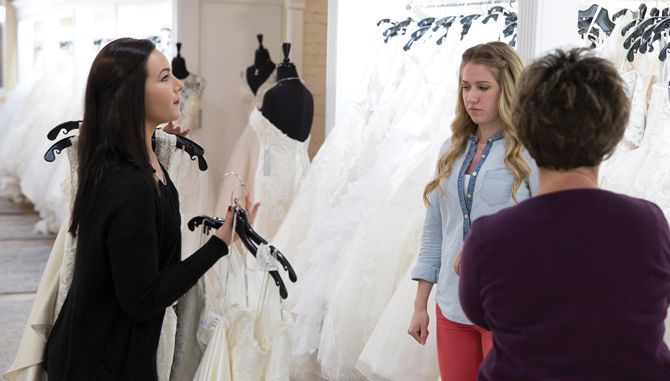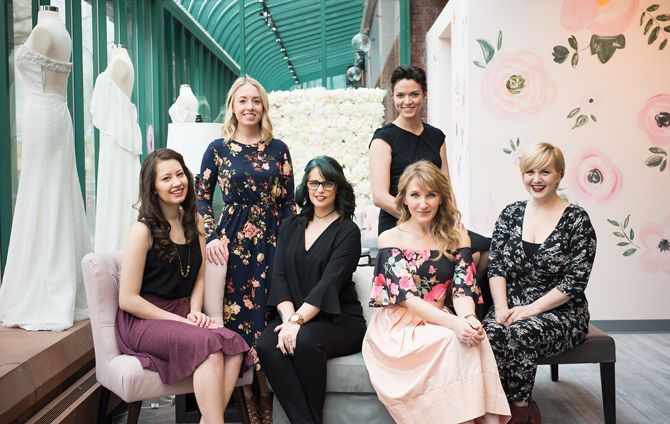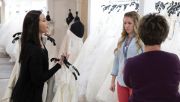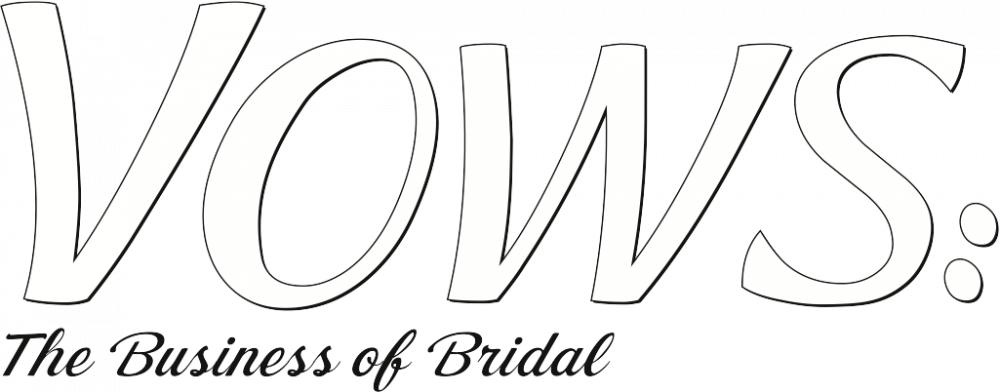When you’re in the business of selling apparel, the clothes you wear quickly become a focal point for your customers.
Indeed, your staff’s appearance has a huge impact on brides looking for advice on selecting a wedding gown, good or bad. This makes it extra important to put thought into what they wear to work.
“As society embraces a more casual vibe, it can become muddled as to what is accepted in the work environment without guidelines,” says Jill Nelson, owner of Mia Bridal Couture in Houston, Texas. “We must remember that our brides are spending a lot of money for one of the most expensive dresses they will wear. We need to look confident selling a $5,000 gown. It’s OK for a bride to come in wearing yoga pants but it’s not OK for us to sell her a wedding gown in them.”
Every salon has a different policy and thought behind what they expect their employees to wear to work each day, but one thing remains true for each – everyone expect their staff to look their best. VOWS spoke with five bridal storeowners, each of who enforces a different dress code. Read on for their best tips and advice on implementing a dress code in your store.
Alyssa Pung,
co-owner Becker’s Bridal
Fowler, Mich.
Alyssa Pung, co-owner of Becker’s Bridal in Fowler, Mich., enforces a formal dress code. Her team is asked to wear solid black, business or business casual attire including skirts and tights.
“Black not only looks clean and professional, it is a power-commanding color,” Pung says. “It also helps the customers distinguish who works here. It can be extremely packed in here and it’s helpful to be able to easily make that determination.”
Additionally, Pung asks her employees to cover any tattoos.
“It just keeps things professional, clean and streamline,” she says. “To my knowledge I do not recall any complaints, but some tattoos, in my our opinion, can negate our brand image.”
She says the store is family oriented, classic and elegant. While she personally has no problem with tattoos, she would rather not take a chance.
“If the first thing a customer sees is a bare arm with a name tattoo across the bicep, for example, I am not sure what their initial impression of us may be, but I would rather play it safe,” she says.
Pung adds that its not always easy asking employees to cover up, especially on warm days. However, she feels this is important to maintaining the reputation of the store.
“Seeing thousands of customers a year, we try to keep a more formal image as you never know what they may be interpreting,” Pung says.
Pung has not had many issues enforcing the dress code, but occasionally has had to speak with employees about their interpretation of it.
“We have had to add fine details like skirts must hit the knee and only non-sheer tights after a petty customer complaint, and we also occasionally have seasonal or festive choices that bend professionalism where we must kindly remind them of the solid black policy,” she says.
The complaint Pung mentioned came from a customer who noticed a consultant in a low-cut sundress bending over at the register.
“She was extremely offended that when she saw her from a distance leaning at the counter she could have seen more than she wanted to,” Pung says. “After that, it just wasn’t worth any questionable scenarios with the public scrutinizing our every move.”
Pung’s Best-Dressed Tip: Pung likes her staff to keep their nails clean. She’s open to polish, as long as it’s not a too-bright shade. “An unpolished nail is also less distracting when hands are on the gowns,” she says.
Ashley Krauss, owner
A Little Something White
Darien, Conn.
Ashely Krauss, owner of A Little Something White in Darien, Conn., does not enforce a formal dress code for her employees.
“The reason I don’t is I want the bride to feel as comfortable as possible,” she says. “By dressing more like my customers, and not overly formal, they will feel we are part of their family.”
She says this approach helps customers feel that they are working together with consultants and avoids a “me versus them” feeling.
Additionally, Kraus says she feels her best, and most confident, when she’s comfortable.
“It’s important for consultants to feel comfortable,” she says. “This is a tough industry. You have to work really hard for an hour and a half with a good chance that the customer won’t buy anything. I feel my team will project their best when they are dressed their best.”
Krauss adds that she doesn’t want to require a specific uniform for her team for practicality reasons.
“I’d rather you wear clothes you can wear other places,” she says.
While comfort is key with Krauss, her team is certainly never dressed down for work. Local brides typically reflect the classic, preppy style of the surrounding area and Krauss says her staff for the most part does, too. Their personal styles also reflect the aesthetic of the shop.
“I’m really lucky my people just get it,” she says. “There is never a discussion needed. We all want to look our best, and portray our best self, on a day we have a lot of appointments.”
Team members typically wear slim-fitting dress pants and a blouse. They usually wear brands like J.Crew, Ann Taylor and Zara.
Krauss says she won’t tolerate anything too bold, something with a political message or anything too short, too low or too tight.
“If customers are looking at you like ‘what is she wearing?’ they are focused on the wrong thing,” she says. “You don’t want them to be distracted from the appointment.”
But that doesn’t mean Krauss wants her staff to blend into the background.
“In general we all dress stylish, but not super fashion-forward,” she says. “Our style is classic with a twist, which is what we say about our gowns. We often get compliments from our customers about our outfits. When that happens, I know we are dressing correctly. Plus, it’s one more way we can bond with the bride.”
Krauss’ Best-Dressed Tip: Krauss likes to start the day in heels and change into flats if necessary. “When I’m planning my outfits I pick things that look good with both heels and flats,” she says.
Elisa Sinkewitz, Owner
The Yellow Brick Road
Huntington, WV
During the week, employees at The Yellow Brick Road, a prom and formal wear boutique in Huntington, W.V., must wear dress pants and blouses but on weekends owner Elisa Sinkewitz requires dress clothes in black and white.
“It’s our busiest days and we like customers to know who works here,” Sinkewitz says. “She may wear black slacks with a white blouse or sweater, or a dress and black shoes in any variation of black and white. She can wear jewelry in any color, and as always hair and makeup is a must.”
Sinkewitz says she doesn’t require an all-black dress code because she felt it was too severe looking.
“Black and white gives people more options and still looks professional while allowing them to show their unique personality,” she adds.
Additionally, Sinkewitz has her employees wear three-pocket waist aprons she purchased from a uniform supply company to help distinguish them from customers. Her staff wears black during the weekdays and yellow on weekends.
“On Saturday and Sunday we are super busy so this helps them stand out,” she says. “We also use a ring system so the apron pockets help with the rings, dress clips and business cards.”
Sinkewitz gives customers plastic shower curtain rings covered in unique patterned tape. Customers place their rings around dresses they would like to try on, then consultants can place those dresses in a fitting room.
Customers are mainly teens shopping for prom and formal dresses, and Sinkewitz’s staff is made up of college-age students 19 to 21. They are all seasonal employees, as the store does not require being highly staffed during the slow season. But Sinkewitz says that having younger, part-time employees does not lead to any problems over the dress code policy.
“I stress how you look at our initial interview,” she says. “That’s really important to me. Before I hire anyone we talk about that a lot. All of our girls dress really well and have a unique style. They have to represent the look and feel of the store.”
Sinkewitz’s Best-Dressed Tip: Looking trendy and fashion forward – with hair and makeup done – is very important for consultants working with prom customers, Sinkewitz says. “If we look put together and polished she will trust our judgment,” she says. “The shop has to represent what we are selling, and so do we. Homecoming and prom girls like to have a young girl help them and they look at her and the way she dresses and does her makeup. They think, ‘she looks good so she can make me look good, too.’”
Jill Nelson, Owner
Mia Bridal Couture
Houston, Texas
“Professionally Fashionable” is how Jill Nelson, owner of Mia Bridal Couture in Houston, Texas, describes her staff dress code. On Saturday employees must wear solid black, while on weekdays the dress code is a little more open to allow for personal style and creativity.
“However, a base of black is required as we never want to distract or outshine the bride, so muted or neutral colors tend to be the best addition,” she says.
Nelson says that she has designed her policy this way so that her employees will be able to embrace their own personal style, while still looking uniform and professional.
“Obviously, many sales consultants are interested in fashion so we want to allow their personality to shine as well as respect the bride’s experience in our shop,” she says.
The functionality of clothing is also something Nelson requires from her staff.
“We realize that our wardrobe must be multi-functional – we are part of the bride’s experience and we strive for each bride to have a wonderful experience at Mia. We must be able to put a dress over our bride’s head, bustle the train on our knees and stand in our shoes for an entire day,” she says.
Nelson says it’s important to distinguish her team, particularly on busy weekends, to help make her customers feel comfortable and welcomed.
“If someone has a question, it’s pretty clear who they can ask,” she says. “We do not require name tags because we find wearing all black or mostly black is distinguishing enough.”
While Nelson has never had any major problems enforcing the dress code, she has dealt with staff members wearing too casual items from time to time.
“We had an employee wear flip flops to work and we addressed that as not being appropriate,” she says.
Additionally, Nelson updated her policy to address that with a line that reads, “If it can be worn to the beach, it doesn’t belong on a team member in the bridal shop!”
Nelson’s Best-Dressed Tip: Nelson has created a training binder that she gives to all new consultants. A written description of her dress code is included and lets employees know from the very beginning what is expected of them. “We ask them to read the entire binder and then I go over each part with them in person so we can talk about each part and they have an opportunity to ask questions,” she says.
Kolby Fahlsing, owner
Flutter Boutique
Minneapolis, Minn.
Kolby Fahlsing, owner of Flutter Boutique in Minneapolis, has relaxed her dress code in recent years.
“I would always let the consultants wear whatever they wanted as long as it was dressy, and was very strict on not wearing jeans or sandals,” she says. “But, with trends and styles changing, we found that when the consultants reflect their personal style, brides felt more comfortable and we started selling more.”
Fahlsing says customers comment on her teams’ personal style and how they are able to put a look together.
“I have a stylist who is very J. Crew while another is very youthful and trendy,” she says. “When brides walk in, they can take a look at us and feel more relaxed and trust us based on how we can style ourselves.”
Showing true personality rather than sporting a simple and uniform look has helped sales. And Fahlsing says that unique hairstyle or tattoos have not impacted this.
“I have had hot pink, blue or green hair in the past,” she says. “I also have several tattoos that are visible. I’m not going to lie, I sell more when I rock a sweet hair color or when people can actually get to see the real me.”
Fahlsing’s Best-Dressed Tip: Utilize your merchandise where you can. In the past, Fahlsing sold tulle skirts and her staff would wear them for special events or parties. “We never had a dress code for them,” she says. “We sometimes all wore tulle skirts to an event, and would occasionally have more than one girl wearing one on a weekend while working, but it was never a planned thing, or something that was required. We absolutely had positive feedback from the skirts, as they are so fun and attention grabbing, and we were selling them in the store at the time, so it increased interest.”
Special Thanks to Store Sources:
A Little Something White, Darien, Conn. – Twitter: @LittleSomeWhite
Becker’s Bridal, Fowler, Mich. – Twitter: @BeckersBridal
Flutter Boutique, Minneapolis, Minn – Twitter: @FlutterBoutique
Mia Bridal Couture, Houston, Texas – Twitter: @MiaBridal1
Yellow Brick Road, Huntington, WV – Instagram: @yellowbrickroadpromandformals








